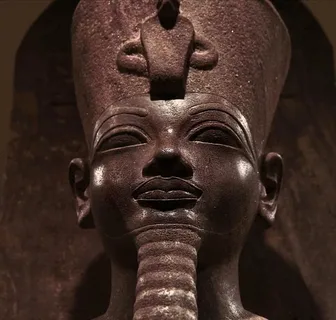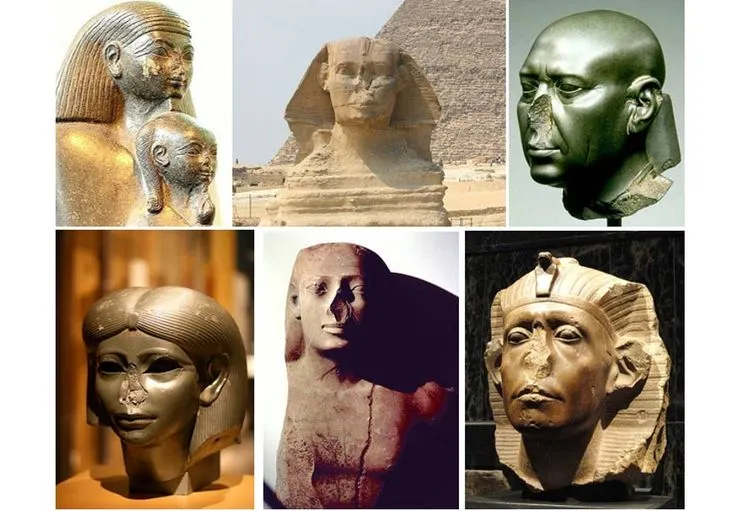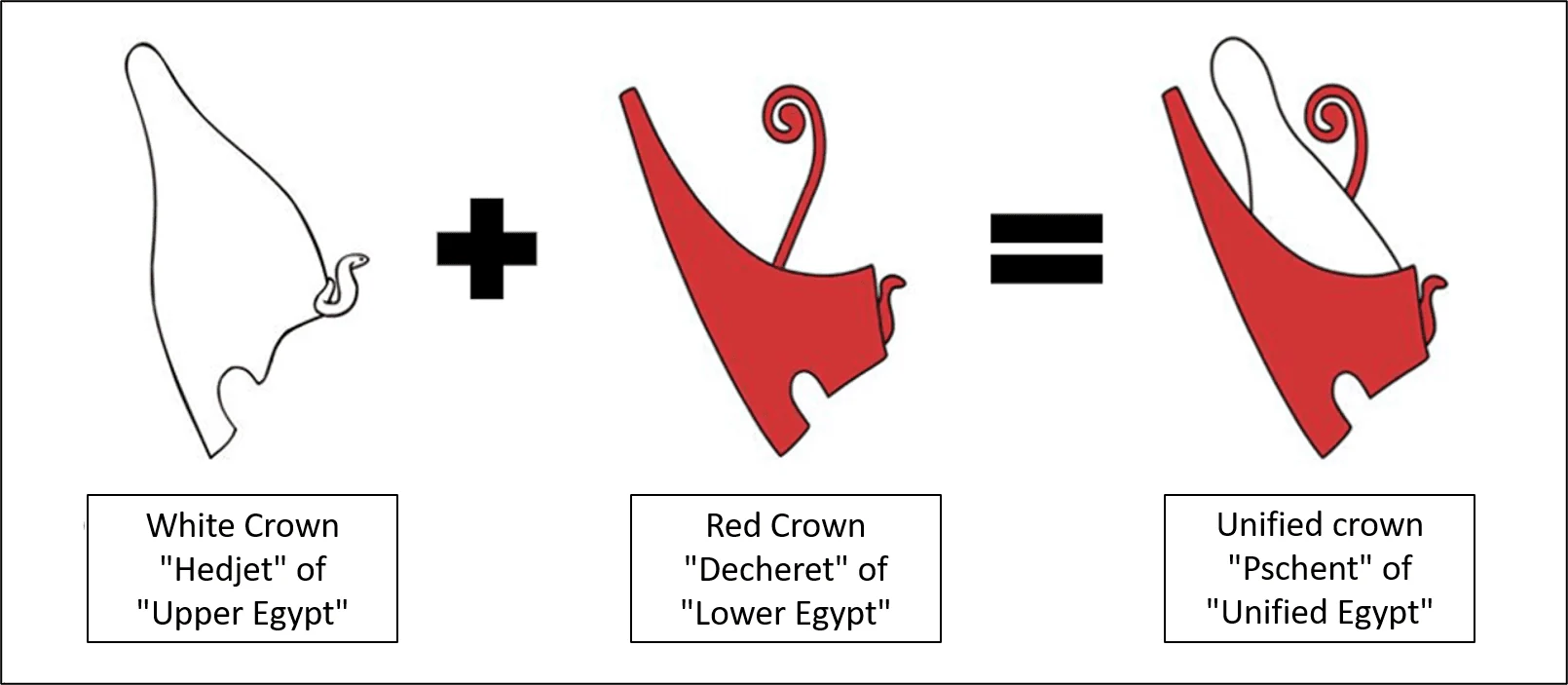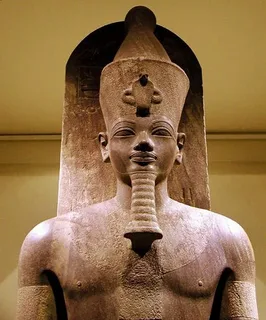The mystery of the Pharaoh’s false beard comes from the story of the god Osiris.
Do you want to discover how the false beard is an inseparable attribute of the pharaohs? Do you want to know what other accessories these Egyptian kings wore?

We are here as Ancient Egypt enthusiasts to guide you and answer all these questions.
The Egyptian false beard is one of the most important attributes of the Pharaoh’s attire, if not the most important. Made of stone or precious metals, this beard is the link between the gods and the Pharaoh.
After reading this article, the appearance and ornaments of the pharaohs will no longer hold any secrets for you, both in their shapes and in their meanings.
Let’s discover the mysteries of pharaonic costumes together!
1) The beard of the pharaohs
Like all rulers, regardless of their era, pharaohs were expected to stand out from the common people. Among the many items of clothing they wore, the most fascinating seems to be the false beard that replaced the pharaoh’s beard.
A) An Egyptian “false beard”…

In ancient Egypt, the Egyptian false beard was, as the name suggests, a false beard. It could only be worn by the Pharaoh. As soon as a ceremony takes place, the Pharaoh is obliged to wear it. The tradition of wearing it is one of the oldest customs of ancient Egypt.
The false beard does not actually look like a beard, but rather a goatee. It was worn on the chin and tied to the ears. It was made of stone and metal and was carefully preserved to be passed down from generation to generation.
The toupee beard was present in all representations of the pharaohs, whatever their form: sculpture, hieroglyphics, drawings…
There are several types of false beards:
– The rectangular false beard was the most common. It was worn by most pharaohs.
– The curved false beard was much less common in ancient Egypt. It was most often worn by the gods when they were represented in the form of statues.

– A false beard integrated directly into a mask. An example is the mask of Tutankhamun, which has a false beard directly embedded into it.
B) The meaning of the false beard
The false beard is one of the attributes common to pharaohs and gods. This essential accessory of their clothing marks the difference between the pharaoh and the common man.
The false beard comes from the story of the god Osiris.
In ancient Egypt, Osiris was considered the perfect example for the pharaohs. He made Egypt prosper in such an extraordinary way that he acquired the status of a god. However, his success attracts the jealousy of his brother Set, who kills him. Upon his death, Osiris finally becomes the ruler of the underworld.
In this Underworld he passes judgment where he appears before the eyes of the judged dead with a beard, displaying his great wisdom. Thus, to get closer and connect with the perfect Pharaoh Osiris, his Pharaonic successors wear a metallic beard to imitate his appearance.

Finally, false beards were not only worn by men. In fact, female pharaohs like Hatshepsut (the first female pharaoh of Egypt) wore them.
Pharaohs always had to be clean-shaven when on public display. The fake beard was therefore the only way for rulers of Egypt to wear a beard.
False beards were worn during the life of the pharaoh and also at his death. Since there were no good or bad circumstances for wearing false beards, they were also present on the sarcophagi of the pharaohs. In fact, when the latter died, they were often represented as the god Osiris himself to facilitate their journey in the world of souls.
2) The symbols of the pharaohs
However, the false beard is not the only pharaonic attribute intended for rulers in ancient Egypt. We also find numerous crowns, scepters and accessories that are symbols of the legitimacy of the pharaohs.

A) The Egyptian crowns
In ancient Egypt there were many types of pharaonic crowns.
The Pschent crown, representing the pharaohs’ ability to rule Lower Egypt and Upper Egypt.
There were three main crowns in ancient Egypt:
– The Hedjet crown is the white crown that represented Upper Egypt (counterintuitively, “Upper” Egypt is located in the south of Egypt and not the north!). It takes the form of a very simple tall hat that becomes increasingly thinner towards the top. The white symbolizes the protection granted to the pharaoh by the vulture goddess of Upper Egypt, Nekhbet.
– The Crown of Decheret is the red crown that represented Lower Egypt (the northern part of Egypt). It is associated with the cobra goddess of Lower Egypt, Wadjet. As it is difficult to describe, we will let you see it in the image above.
– The Pschent crown is a combination of the two previous crowns. Its name comes from the combination of two Egyptian words that together mean “the two powerful ones”. This Egyptian crown is a symbol: it represents the union of Lower and Upper Egypt into one vast and powerful kingdom.
B) Symbols of ancient Egypt

Scepters and the ankh cross are also among the most well-known attributes of pharaohs. In ancient Egypt, both were evidence of the sovereign’s power and divine legitimacy. Like crowns, there are different scepters with many meanings:
– The scourge is the symbol of the sovereignty of southern Egypt. It resembles a whip and has the dual function of agricultural tool and symbol of sovereignty.
– The Heka is the symbol of power in northern Egypt. It resembles a shepherd’s crook and, as its shape indicates, is similar to the role of the Pharaoh in guiding his people in the same way that a shepherd guides his flock.
– The Was scepter is the scepter usually carried by the gods Set and Anubis. Its shape is derived from a stick used to catch snakes. The Was scepter is carried by the Pharaoh during military expeditions against Egypt’s enemies.
– The ankh cross scepter (or “cross of life”) is the symbol of immortality and eternity. In fact, in Egyptian culture the ankh cross represents a gift from the gods to the pharaoh that the latter will share with his people: the guarantee of an afterlife for all those who have lived without committing too many bad deeds on earth.






